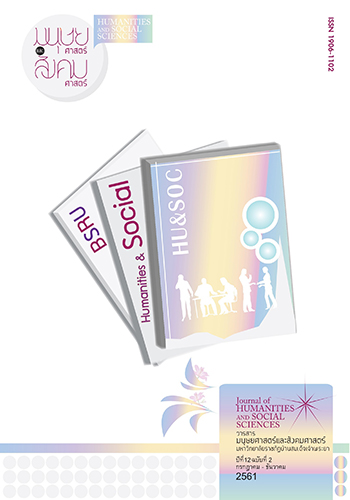กลวิธีการรำของอิเหนาในบทพิลาปร่ำรัก ตอนอิเหนาคะนึงถึงจินตะหราวาตี
คำสำคัญ:
กลวิธีการรำ, พิลาปร่ำรัก, อิเหนาบทคัดย่อ
งานวิจัยฉบับนี้มีวัตถุประสงค์เพื่อ 1.ศึกษาประวัติความเป็นมาของวรรณกรรมเรื่องอิเหนา และการแสดงละครเรื่องอิเหนาของกรมศิลปากร 2.วิเคราะห์รูปแบบและองค์ประกอบในการแสดงละครเรื่องอิเหนา ตอนอิเหนาคะนึงถึงจินตะหราวาตีของกรมศิลปากร และ 3.วิเคราะห์กลวิธีการรำของอิเหนาในบทพิลาปร่ำรัก ตอนอิเหนาคะนึงถึงจินตะหราวาตี ตามแนวทางของครูวันทนีย์ ม่วงบุญ มีวิธีการดำเนินการวิจัยตามกระบวนการวิจัยเชิงคุณภาพ โดยศึกษาจากหนังสือ ตำรา งานวิจัยที่เกี่ยวข้อง สื่อพิมพ์และบทความ ตลอดจนสื่ออิเล็กทรอนิกส์ และลงภาคสนามเพื่อฝึกปฏิบัติท่ารำ รวบรวมข้อมูลจากการสัมภาษณ์ และตรวจสอบความถูกต้องของข้อมูลโดยการจัดสัมมนากลุ่ม (Focus group) ผลการศึกษาพบว่า 1.วรรณกรรมเรื่องอิเหนามีที่มาจากนิทานปันหยีของชวาแพร่มาสู่ประเทศไทยในสมัยอยุธยา อิเหนาพระราชนิพนธ์รัชกาลที่ 2เป็นฉบับที่ได้รับความนิยมสูงสุดและเป็นฉบับที่กรมศิลปากรใช้มาเป็นบทในการจัดการแสดงมาจนถึงปัจจุบันนี้ 2.การแสดงละครเรื่องอิเหนา ตอนอิเหนาคะนึงถึงจินตะหราวาตี ของกรมศิลปากร มีรูปแบบการแสดงที่แตกต่างจากละครใน คือ บทละครมีการปรับปรุงให้กระชับขึ้น ดนตรีและเพลงร้องมีการตัดและเพิ่มเพลง ผู้บรรเลงและขับร้องมีทั้งหญิงและชาย ผู้แสดงมีทั้งหญิงและชายแต่นิยมใช้ผู้หญิงแสดง เครื่องแต่งกายมีการปรับปรุงลวดลายและวิธีการปักตัวอิเหนาสามารถสวมเสื้อได้ทั้งแบบแขนสั้นและแขนยาว มีการใช้ฉาก และอุปกรณ์การแสดงแบบสมจริง ส่วนท่ารำพบว่ายังคงรักษาจารีตละครในไว้ 3.กลวิธีการรำของอิเหนา ตอนอิเหนาคะนึงถึงจินตะหราวาตี เป็นการรำในบทพิลาปร่ำรักมีกลวิธีในการรำ ดังนี้ 1) กลวิธีในการสื่ออารมณ์ แบ่งออกเป็น 3 ช่วง คือ ช่วงกระวนกระวายใจ ช่วงตกหลุมรัก และช่วงเสียใจ สื่อได้โดยใช้สีหน้าและท่าทางคือใช้ คิ้ว ตา ปาก และใช้ภาษาท่าต่าง ๆ ประกอบกันให้พอเหมาะ 2) กลวิธีการมอง คือ การมองนางจินตะหราวาตีในทิศทางเดียวกันทุกครั้ง การมองตามมือและมองตามบทเพื่อสื่ออารมณ์และความหมาย ทำให้ท่ารำดูสวยงามยิ่งขึ้น 3) กลวิธีการนั่งรำและยืนำ ช่วยสื่ออารมณ์กระวนกระวายใจ อารมณ์ตกหลุมรัก ทั้งช่วยส่งเสริมบุคลิกภาพของผู้แสดงให้สง่างาม และ 4) กลวิธีการใช้หน้า คือ กล่อมหน้า เพื่อใช้เชื่อมท่าให้ท่ารำต่อเนื่องกลมกลืนกัน
เอกสารอ้างอิง
กรมศิลปากร. (2540). สูจิบัตรรายการศรีสุขนาฏกรรม. [สูจิบัตร]. กรุงเทพฯ : กรมศิลปากร.
ดำรงราชานุภาพ, สมเด็จพระเจ้าบรมวงศ์เธอ กรมพระยา. (2508). ตำนานละครอิเหนา. (พิมพ์ครั้งที่ 4). กรุงเทพฯ : คลังวิทยา.
พจนานุกรมไทยฉบับราชบัณฑิตยสถาน พ.ศ.2554. (2556). กรุงเทพฯ : อักษรเจริญทัศน์.
ไพโรจน์ ทองคำสุก. นักวิชาละครและดนตรีชำนาญการ. (สัมภาษณ์, 7 สิงหาคม 2650).
รุ่งอรุณ แซ่อึ้ง. (2538). วิเคราะห์อารมณ์เศร้าของตัวละครในวรรณคดีไทย เรื่อง ขุนช้างขุนแผน พระอภัยมณี อิเหนา และรามเกียรติ์. วิทยานิพนธ์ปริญญาการศึกษามหาบัณฑิต สาขาวิชาภาษาไทย มหาวิทยาลัยมหาสารคาม.
วันทนีย์ ม่วงบุญ. ผู้เชี่ยวชาญด้านนาฏศิลป์ไทย. (สัมภาษณ์, 7 สิงหาคม 2560).
อารดา สุมิตร. (2516). ละครในของหลวงในสมัยรัชกาลที่ 2. วิทยานิพนธ์อักษรศาสตรมหาบัณฑิต แผนกวิชาภาษาไทย จุฬาลงกรณ์มหาวิทยาลัย.
ดาวน์โหลด
เผยแพร่แล้ว
รูปแบบการอ้างอิง
ฉบับ
ประเภทบทความ
สัญญาอนุญาต

อนุญาตภายใต้เงื่อนไข Creative Commons Attribution-NonCommercial-NoDerivatives 4.0 International License.




